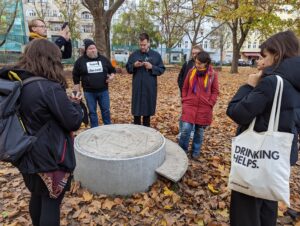Active Citizenship
COLLABORATIVE DECISION-MAKING
EXPLORATION & KNOWLEDGE SHARING
Active citizenship refers to the power of individuals or small groups of residents to proactively engage in community-related activities to improve their city or neighbourhood.
Short summary of the practice
Active citizenship in this context refers to the power of individuals or small groups of residents to proactively engage in community mapping exercises to improve their city or neighbourhood. Being an active citizen means being part of the community through individual civic engagement and exercising rights and responsibilities in a balanced way.
Goal of the practice
Identify and address community problems or overlooked issues in the development of the neighbourhood.
Target group
Residents of the city
Number of participants: One person or small group up to 8 people
Age of participants: Young people and adults, 12+
Materials
Varies depending on the focus and scope of the project. However, there may be a need for mobile phones and cameras to collect evidence for urban-based projects and print/digital materials for workshops, paper, pens, pencils, physical/digital maps.
Method Settings
Varies depending on the focus and scope of the project. May require urban or workshop space, digital platform to initiate discussion.
Duration
Varies depending on the focus and scope of the project. However, it’s the long-term projects that require time not only to research the topic but also to initiate activities.

Preparation
Varies depending on the focus and scope of the project.
Preparation may include researching historical facts about the currently neglected or problematic urban spaces, organising a local workshop with residents to gather ideas and opinions, writing a blog post or conducting an online survey.
If the project involves children and young people, some materials and resources need to be explored and implemented depending on the aim of the project (see References and Resources here).
Step by step guide
Resident-initiated mapping projects are diverse. However, they tend to be inspired by acute community problems or neglected neighbourhood development issues.
Citizens can document the neglected spaces in the city by taking photos and adding them to the map if they have the opportunity and skills. A discussion can then be started on the local community platforms. Ideally, an active group can be formed to initiate some changes.
Expected output
The results of mapping projects powered by active citizenship can differ depending on their objectives and the ability of the organizers to deliver. Yet, a common thread among these projects is a compelling map that underscores community concerns and emphasizes the call for change or action.
DOs, DONTs and ethical considerations of the method
Do share constructive content.
Avoid sensitive or sexual content.
Change the method brings to the communities
Active citizenship can trigger far-reaching changes in communities and policies. However, its success depends on many factors. The resonance of the topic, the techniques of data gathering and communication, and ensuring that the right stakeholders are engaged at key moments are all key to achieving meaningful impact.
Adaptation/Application of the method
The method can be adapted to any context by anyone, provided they have the drive and passion to effect change. Consider the MAXICO case study, “Mapping Helsinki’s Gravel Fields.” In this instance, a Helsinki resident took it upon himself to spotlight the underutilized gravel fields within the city’s inner parks. Aiming to ignite discussions about smarter public space utilization and the enhancement of urban life quality, he meticulously mapped, observed, and photographed these fields. His efforts culminated in an online map and a detailed blog.
Credit, References, and Resources
Mapping Helsinki’s Gravel Fields – https://urbanfinland.com/2022/08/10/what-is-the-future-for-helsinkis-mini-deserts/
The Centre of Democracy blog post – Active Citizenship – https://www.centreofdemocracy.sa.gov.au/active-citizenship/
Active citizenship in a democracy – https://www.rememberingresistance.com/active-citizenship.html
Applying Active Citizenship Indicators to Practice, the resource that has been developed as a supplement to Multicultural Youth Advocacy Network’s (MYAN – Australia) National Youth Settlement Framework (NYSF) – https://myan.org.au/wp-content/uploads/2020/06/nysf-applying-active-citizenship-indicators-to-practice_.pdf
A collection of resources from Young Citizens – a citizenship education charity. It helps educators offer inspiring citizenship education for their pupils and students – both as a part of the curriculum and beyond – https://www.youngcitizens.org/
Scientific papers:
Students as active citizens: A systems perspective on a Jean Monnet module, experiential learning and participative approaches – https://www.researchgate.net/publication/333771976
Active Citizenship: An Empirical Investigation – https://www.researchgate.net/publication/232005356
Related posts

ArcGIS Online
ArcGIS Online provides a cloud-based mapping and analysis solution. It is used to create interactive web maps, analyse data, share and collaborate.

Civic Alert
Civic Alert is a platform designed to facilitate communication between citizens and governments. Citizens can use their mobile application to report problems in the city to the authorities in three easy steps.

CIVIC LABS – Civic technology solution generator
Civic Labs is a set of practices to ensure citizen access and transparency to public data, and to provide citizens with digital tools to help them make the best decisions to improve the lives of communities.
